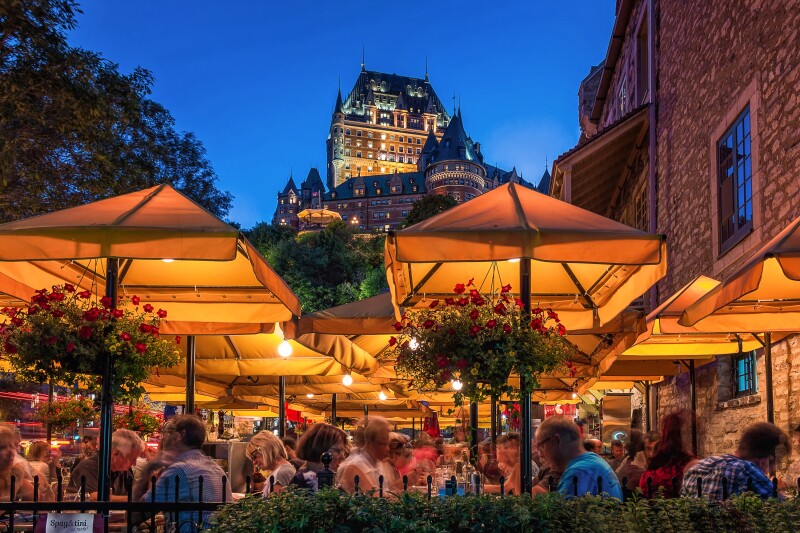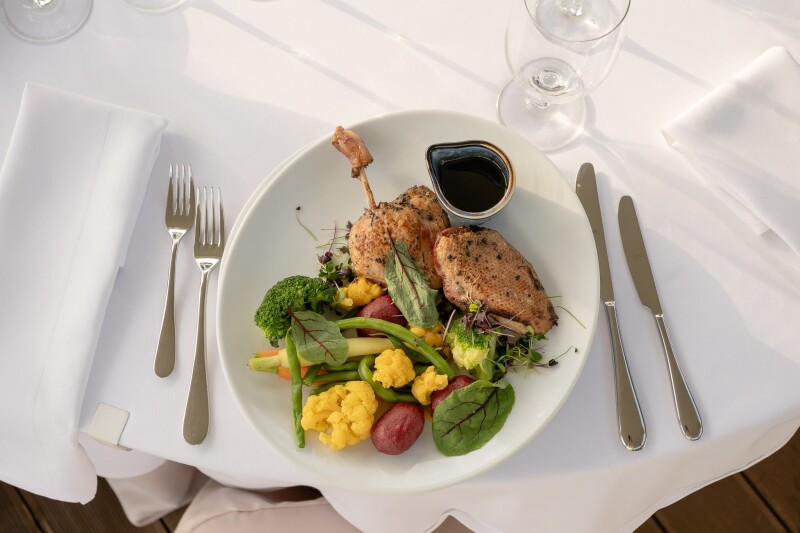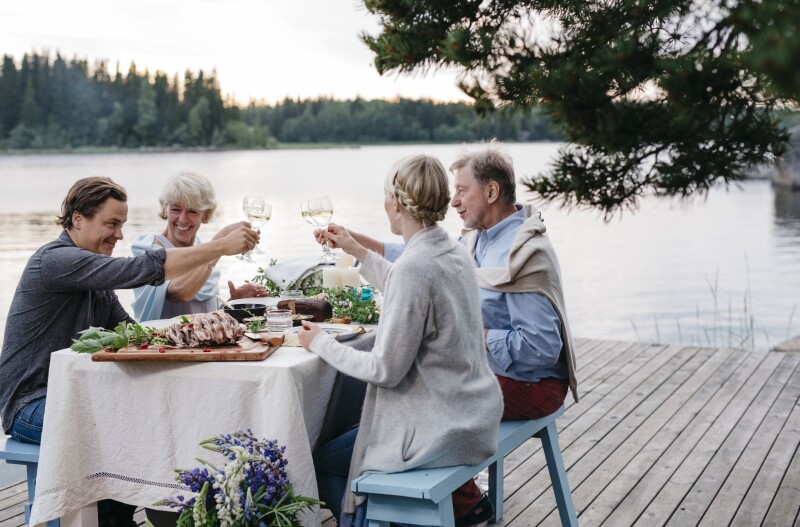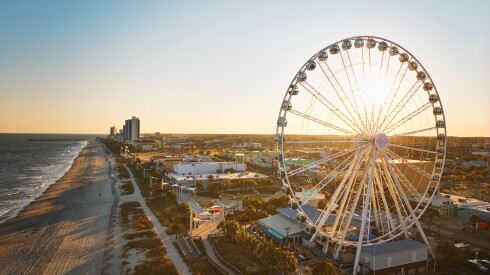Culinary legacies run deep, and authenticity remains in full flavor—if you know where to explore. Step into the Global Kitchen, a new video series from the United States Tour Operators Association (USTOA) that invites you to savor the flavors and immerse yourself in the traditions behind the best-loved dishes of Québec, Canada; Poland; Malta; and Finland. Join the most celebrated and rising-star chefs and local tour guides from those countries as they pluck the tastiest morsels from street food stalls and markets, delighting in new tastes and eye-opening experiences.
Plus, the Global Kitchen Cookbook features recipes from the four countries as well as stories and dishes from Buenos Aires, Colombia, Germany, Lanzarote, Laos, Morocco, Thailand, Vietnam, and Zagreb. Learn to make mouthwatering morsels, like prawns with kaffir lime leaves and lemongrass or beef empanadas, and let the lush landscapes on the cookbook’s pages inspire your next trip.
The new videos bring to life the hallmarks of travel with USTOA tour operator members—responsible explorations with trusted guides that dive deeper into a destination. A food-focused group tour that makes menus your maps is perhaps the most hands-on way to travel, and in these new videos, adventure is just as educational as it is delicious.
Listen for the clink of glasses toasting Finland’s most popular cocktail and the squeak of authentic cheese curds atop poutine in Québec in the episodes. USTOA has always been about travel that’s food for thought, from breaking traditional ftira bread in Malta to discovering why “milk bars” have little to do with drinking in Poland. That’s just a sample of what awaits in this series by USTOA, which has been a dependable traveler resource for thoughtful, sustainable, and authentic experiences for more than 50 years.
Bagels and more in Montréal
Québec’s warm summers and pristine winters help create the perfect terroir for the province’s legendary culinary treasures. From maple groves producing liquid gold to vineyards resulting in moscato-like ice wines and forests yielding wild chanterelles and morels, the magnificent landscape and majestic St. Lawrence River shape a cuisine unlike anywhere else. Over centuries, settlers adapted traditions to Québec’s unique bounty—wild blueberries, fiddleheads, maple sap, and the abundant fish of the St. Lawrence River—creating a fusion that’s distinctly French Canadian.
In the video above, watch as local culinary expert Daniel Bromberg leads a street food adventure through Montréal, one of Canada’s most diverse cities. Joined by Chef Ruby Gatt of Larry’s restaurant, who passionately champions Québecois products, Bromberg guides viewers through cherished institutions of gastronomy—from Schwartz’s smoked meat sandwich to the timeless charm of Wilensky’s and the $5 gnocchi at Drogheria Fine. Throughout, Bromberg shares his insider knowledge of Montréal’s dynamic food scene, revealing the stories behind these neighborhood gems that define the city’s remarkable culinary identity.

Diners al fresco in Québec City with Fairmont Le Château Frontenac in the background
Courtesy of Region de Québec/Emmanuel Coveney
Montréal’s famous bagels are also integral to its identity, stemming from Jewish and Eastern European roots. Behind the scenes at St. Viateur, where lines often wrap around the block, Bromberg and Gatt discover the fascinating history of bagels. The meticulous nine-step process—unchanged since 1957—involves boiling dough in steaming honey water before baking it in wood-burning ovens for an evenly browned yet chewy bite.
Gatt also takes you into the café kitchen she helms at Larry’s in Montréal’s Mile End neighborhood, which transforms into a wine bar in the evening and reflects a love of all things regional and seasonal. The signature burrata with mixed oyster mushrooms features cheese from a family-owned fromagerie, balsamic vinaigrette made with grapes foraged in Québec, and flaky St. Lawrence River salt.
Visit a seaside fish market and break bread in Malta
At 17 miles long and nine miles wide, Malta is a veritable buffet of flavors influenced by a succession of rulers that have included the Romans, Arabs, Knights of Saint John, French, and British. The archipelago’s central Mediterranean location at the crossroads of key east-west and north-south trade routes has always meant that there’s no such thing as “fusion” cuisine—the melding of cultures and flavors is simply a way of life. Across the islands, fishermen still use palm leaves to make rafts for catching lampuka (also known as mahi mahi). You’re as likely to find that on a plate as rabbit stew in a bowl, simmered for hours in wine, garlic, and herbs like fennel.

A pastizzi pastry in Malta
Courtesy of Visit Malta/Emily Hartwig
In the episode, sail along with chef Victor Borg, self-proclaimed “culinary storyteller,” to learn the secrets of Maltese favorites such as the diamond-shaped flaky pastizzi pastry. The method in which they’re folded, either down the middle or the side, determines whether the filling is ricotta or pea.
While pastizzi are savory, date-filled imqaret pastries mix sweetness and earthy flavors. They’re just one of the many street foods in the video that Borg will introduce you to at Marsaxlokk Sunday Fish Market, an open-air market where the mode of transportation is the traditional brightly colored boats called luzzu.
Malta also has one of the few edible delights on UNESCO’s Intangible Cultural Heritage List, ftira. The ring-shaped, flattened sourdough bread (usually served with capers, tuna, olives, and fresh tomatoes) is likely to be found in nearly every home and bakery. But the delicate dough can only be handmade by the most skilled bakers.
Pierogies, kielbasa, and more comfort food await in Poland
Like rivers that have been connecting countries and people for millennia, Poland’s longest, the Vistula, still ties the massive nation together as a means of trade, transport, agriculture, and energy. In Warsaw, this spirit is alive along Vistula Boulevard, a three-mile-long riverside promenade dotted with cafés, bars, and a sandy beach ideal for watching the sunset over dinner from one of the dozens of food trucks ringing the riverbanks. Pierogies are the country’s most iconic food, but on any given night here, you’ll also catch a whiff of grilled kiełbasa in the air. Zapiekanka, a toasted open-faced sandwich on a long bun with onions and mushrooms, topped with cheese and ketchup, is also common.

A restaurant meal in Poland
Courtesy of the Polish National Tourist Office/Andrzej Pawluszek/Tomasz Bartoszyński.
Another place in Poland’s capital whose culture is synonymous with reinvention—and refueling is Elektrownia Powiśle. The historic former power plant’s glory has been restored as a light-filled food hall with restaurants like Ćma nad Wisłą, where a favorite dish is the traditional żurek (sour rye soup).
For a taste of tradition that suits everyone from Grandma to budget-conscious co-eds, you’ll want to hit up one of the no-frills spots called mleczny. Translated as “milk bar,” the cafeteria-style restaurants became popular after World War II for inexpensive comfort foods like cabbage and kotlet schabowy (breaded pork cutlet).
Chef Marcin Przybysz puts a contemporary spin on such classics, and in this video with the Top Chef finalist, you can discover some of his favorites. Visit Poland yourself for experiences like a midnight snack with live music at the Warsaw Night Market. Moonlight illuminates open-air dining in a former railway station, where brews from Poland’s emerging craft beer scene also await.
Cardamom pastries in Finland
Renowned for its foraging culture, Finland also has many more culinary dimensions beyond the mushrooms, berries, and herbs that grow wild in the countryside and across vast swaths of its capital, Helsinki.
The country’s geography—and its cuisine—are a study in contrasts. You’re likely to find sustainably raised or consciously caught game or lamb on just about any menu, and sirloin steak with creamy onion sauce is the favorite at Restaurant Elite. But fish reigns supreme when it comes to street snacks such as Baltic herring and open-faced smoked salmon sandwiches on rye bread. Although Finnish cheese is also popular, Finns say muikku, which is the ubiquitous fried vendace white fish, instead of saying “cheese” when taking pictures.
In this video, chef Henri Alén (whose restaurant Finnjävel Salonki is one of many in Finland to earn a Michelin star) treks through Helsinki and Finland’s oldest city, Turku, which is renowned as the country’s food capital. Savor rice porridge–filled Karelian pies, crimped “just so” at the edges to bake evenly, or sip a sparkling, lightly sweet and sour lonkero. The refreshing drink, made with gin and grapefruit soda, was one of the world’s first ready-made drinks when it was invented for the 1952 Olympics in Finland. It’s been an integral part of cocktail culture here ever since.

Dining lakeside in Finland
Courtesy of Visit Finland/Elina Manninen
Baking, such as archipelago bread and sourdough, also helps define Turku’s food scene. When it comes to those with a sweet tooth, pink-frosted piispis doughnuts are one of the more common specialties in the city. Flaky pastries like pulla are emblematic of much of Finnish cuisine, as they delicately balance sweet and savory, crunchy and fluffy, and are flavorful yet simple. The butter buns typically feature a touch of cardamom with a sprinkle of sugar on top.
You’ll also find more desserts in the video series, from the distinctive slices of Tony’s Ice Cream in Malta to Kem Coba’s inventive ice cream flavors, such as cardamom-orange in Montréal. In Poland, paczki, glazed pastries filled with fresh fruit preserves that are similar to donuts, await. It’s all part of how USTOA tour operator members take you deeper into food culture and beyond.
Try your hand at featured recipes from these four destinations and the others featured in the Global Kitchen cookbook. Then, follow your taste buds with USTOA tour operator members on immersive culinary journeys that highlight the most beloved and unexpected flavors each destination has to offer.










